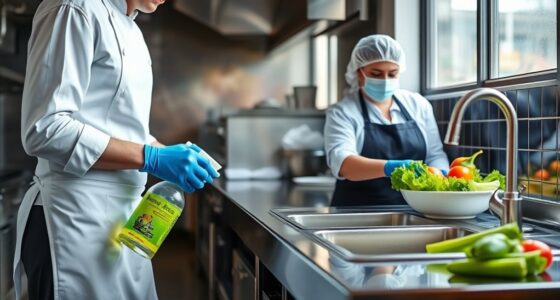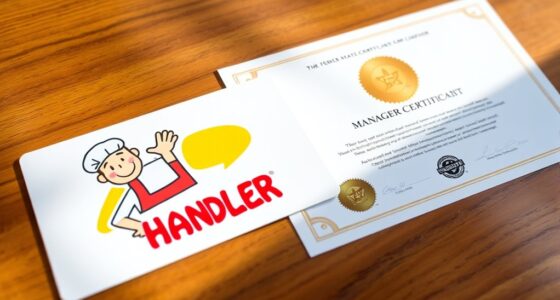In the kitchen, you should wear PPE like gloves, aprons, and hairnets when handling raw meat, seafood, or ingredients prone to bacteria, and when working with cleaning chemicals. Always wash your hands before donning PPE and change gloves frequently to prevent cross-contamination. Keep your PPE clean and replace it if soiled or damaged. Following proper donning, doffing, and hygiene practices helps protect food safety and your health. If you continue exploring, you’ll discover how to implement these tips effectively.
Key Takeaways
- Wear gloves when handling raw meat, seafood, or bacteria-prone ingredients, and change them frequently.
- Use aprons and protective clothing to prevent contamination from clothes and keep food safe.
- Use PPE like gloves and masks when working with cleaning agents and sanitizers to prevent chemical exposure.
- Always wash hands thoroughly before and after using PPE to maintain proper hygiene.
- Regularly clean, disinfect, and replace PPE items to ensure they remain effective and prevent pathogen spread.

Have you ever considered how personal protective equipment (PPE) can keep you safe while working in the kitchen? PPE plays a critical role in maintaining food safety and hygiene practices, protecting both you and the food you’re preparing. When you wear gloves, aprons, or hairnets, you’re not just following regulations—you’re actively preventing contamination and ensuring that the meals you serve are safe for your customers or family. Proper use of PPE helps minimize the risk of cross-contamination from bacteria, hair, or other foreign objects that can compromise food quality and safety. Incorporating the use of cleaning agents and sanitizers alongside PPE can further enhance hygiene standards in your kitchen.
Using gloves is essential, especially when handling raw meat, seafood, or ingredients that are prone to bacterial contamination. When you put on gloves, make sure your hands are clean beforehand, and change them frequently, particularly after touching raw products, waste, or any contaminated surfaces. Gloves shouldn’t replace good hygiene practices but should complement them. Remember to wash your hands thoroughly before and after glove use, as gloves can give a false sense of security if not handled properly. Wearing gloves during food prep is a straightforward way to prevent germs from transferring onto the food you’re working with.
Always wash your hands before and after using gloves to ensure proper hygiene.
Aprons and protective clothing are equally important, especially when working with ingredients that can stain or carry bacteria. An apron acts as a barrier, preventing your clothes from contaminating food and vice versa. Ensure your apron is clean and changed regularly, especially if you notice it’s soiled. Covering your hair with a hairnet or cap reduces the risk of hair falling into food, which is a common hygiene issue in kitchens. These PPE items are simple but effective tools for maintaining food safety standards and supporting hygiene practices. Regularly cleaning and disinfecting PPE items like aprons and hairnets also helps prevent the spread of bacteria and other pathogens.
It’s also essential to use PPE when handling cleaning agents or sanitizing surfaces, as chemicals pose health risks if they come into direct contact with skin or food. Properly fitted gloves and masks protect you from exposure and prevent chemical contamination of food. Remember, PPE should never be a substitute for good hygiene; always wash your hands thoroughly, keep your workspace clean, and follow proper food handling procedures.
Frequently Asked Questions
Can PPE Be Reused Safely in the Kitchen?
Yes, you can reuse PPE in the kitchen if you follow proper PPE maintenance. Reusable PPE like gloves and aprons should be cleaned and disinfected thoroughly after each use to guarantee safety. Regularly inspect your PPE for damage or wear, and replace it when necessary. Proper maintenance prevents contamination, keeps you safe, and extends the lifespan of your reusable PPE, making it a reliable option for kitchen safety.
What Types of PPE Are Most Cost-Effective?
Think of choosing PPE as investing wisely in your kitchen’s safety. The most cost-effective options include reusable gloves and aprons, which save money over time compared to single-use items. PPE investment should focus on durability and proper maintenance, reducing replacement costs and waste. By selecting versatile, long-lasting gear, you guarantee safety without breaking the bank, turning protection into a smart, ongoing investment that benefits both your budget and your team’s well-being.
How Do I Properly Dispose of Contaminated PPE?
To properly dispose of contaminated PPE, you should first carefully remove it to avoid spreading contamination. Place used PPE in designated, leak-proof disposal bags or containers. Seal these securely before discarding them in the appropriate waste bin. Always wash your hands thoroughly afterward to prevent contamination spread. Proper disposal helps protect you and others, maintaining contamination prevention and ensuring a safe, hygienic environment.
Are There Specific PPE Requirements for Allergy Safety?
You should prioritize allergy safety by using allergy-specific PPE, like gloves and masks, whenever handling allergy-prone ingredients. These safety protocols help prevent cross-contact and protect sensitive customers. Always make certain your PPE fits properly and is changed regularly. Adhering to allergy safety protocols isn’t just a recommendation; it’s essential for maintaining a safe and inclusive kitchen environment. Your attention to this detail can make all the difference in allergy safety.
How Often Should PPE Be Replaced During Busy Shifts?
During busy shifts, you should replace PPE regularly to maintain durability and safety. Typically, gloves and aprons should be changed between tasks or when contaminated, while masks and hairnets are replaced at set intervals or when damaged. Staff training emphasizes recognizing signs of PPE wear and tear, ensuring you replace items promptly. Consistent replacement helps prevent cross-contamination and keeps safety standards high throughout your shift.
Conclusion
Remember, wearing the right PPE in the kitchen protects you and guarantees food safety. Whether it’s gloves, aprons, or hairnets, each piece plays a crucial role. Did you know that proper PPE use can reduce contamination risks by up to 70%? So, always prioritize your safety and hygiene. When you’re diligent about PPE, you create a safer, cleaner environment—keeping everyone healthier and the kitchen running smoothly. Stay protected and cook with confidence!









